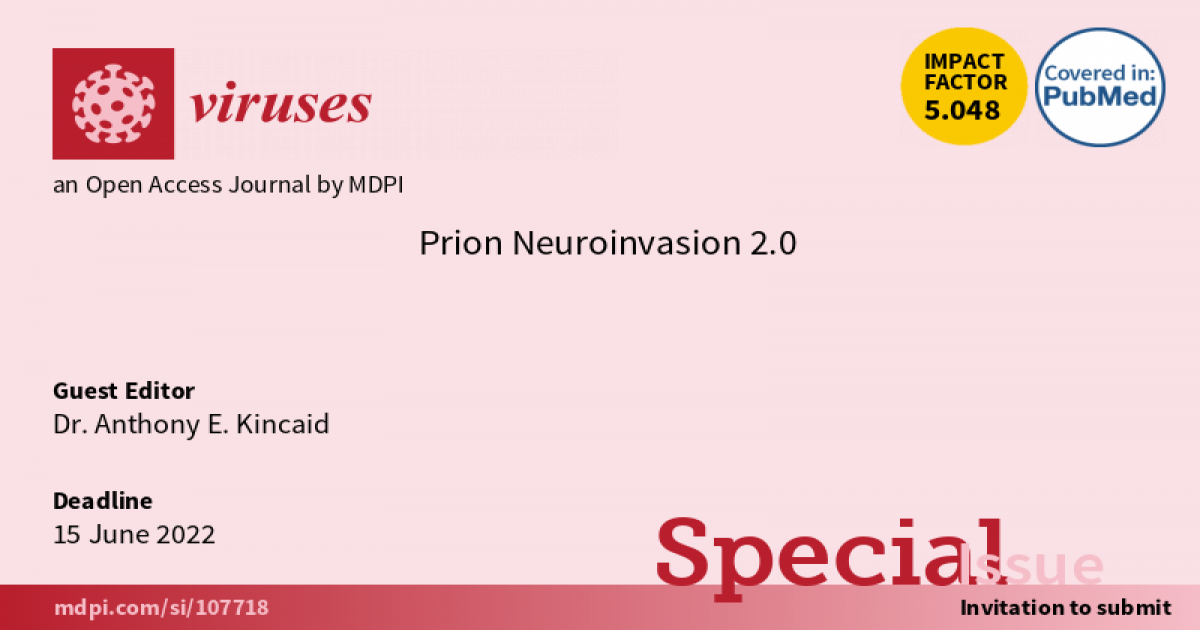Prion Neuroinvasion 2.0
A special issue of Viruses (ISSN 1999-4915). This special issue belongs to the section "Prions".
Deadline for manuscript submissions: closed (15 June 2022) | Viewed by 5251

Special Issue Editor
Interests: prion pathogenesis;specifically the characterization of routes of entry and mechanisms of centripetal and centrifugal spread of prions in the nervous system
Special Issues, Collections and Topics in MDPI journals
Special Issue Information
Dear Colleagues,
Prion diseases are a class of fatal neurodegenerative diseases that affect animals, including humans. The causative agent is a misfolded protein that is sometimes inherited and the result of an iatrogenic procedure, but more commonly, prions gain access to the interior of the body by crossing the epithelium of the gut, nasal cavity, or the skin.
While much work has been carried out on the pathogenesis of prion diseases, there are several questions that remain unanswered, including the cellular and molecular events of prions crossing the epithelial tissue, the role of blood in the spread of prions, the specific mechanism(s) of how prions enter and spread centripetally in the peripheral and central nervous systems, and how prions spread centrifugally to peripheral tissues where they are shed.
The focus of this Special Issue is the process of prion entry and neuroinvasion, the spread of prions in the central and peripheral nervous systems, and the mechanism(s) of neuronal cell death.
Dr. Anthony E. Kincaid
Guest Editor
Manuscript Submission Information
Manuscripts should be submitted online at www.mdpi.com by registering and logging in to this website. Once you are registered, click here to go to the submission form. Manuscripts can be submitted until the deadline. All submissions that pass pre-check are peer-reviewed. Accepted papers will be published continuously in the journal (as soon as accepted) and will be listed together on the special issue website. Research articles, review articles as well as short communications are invited. For planned papers, a title and short abstract (about 100 words) can be sent to the Editorial Office for announcement on this website.
Submitted manuscripts should not have been published previously, nor be under consideration for publication elsewhere (except conference proceedings papers). All manuscripts are thoroughly refereed through a single-blind peer-review process. A guide for authors and other relevant information for submission of manuscripts is available on the Instructions for Authors page. Viruses is an international peer-reviewed open access monthly journal published by MDPI.
Please visit the Instructions for Authors page before submitting a manuscript. The Article Processing Charge (APC) for publication in this open access journal is 2600 CHF (Swiss Francs). Submitted papers should be well formatted and use good English. Authors may use MDPI's English editing service prior to publication or during author revisions.
Keywords
- prion pathogenesis
- prion entry
- prion neuroinvasion
- transport in nerves
- spread in the central nervous system
- centrifugal and centripetal spread of prions
- prionemia
Benefits of Publishing in a Special Issue
- Ease of navigation: Grouping papers by topic helps scholars navigate broad scope journals more efficiently.
- Greater discoverability: Special Issues support the reach and impact of scientific research. Articles in Special Issues are more discoverable and cited more frequently.
- Expansion of research network: Special Issues facilitate connections among authors, fostering scientific collaborations.
- External promotion: Articles in Special Issues are often promoted through the journal's social media, increasing their visibility.
- e-Book format: Special Issues with more than 10 articles can be published as dedicated e-books, ensuring wide and rapid dissemination.
Further information on MDPI's Special Issue polices can be found here.






